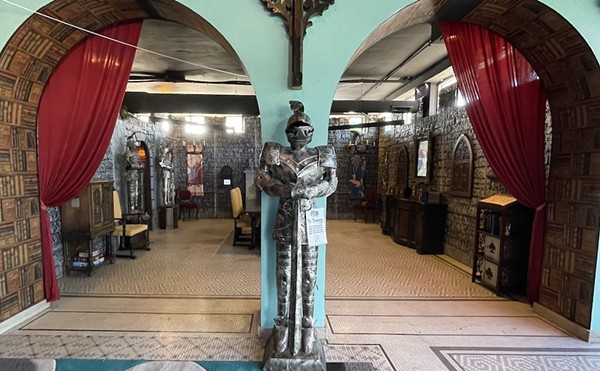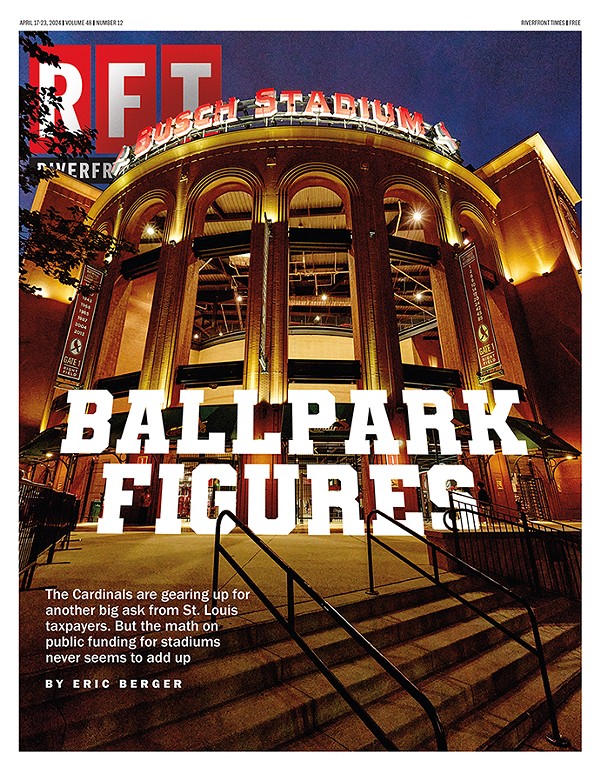Carmon Colangelo: Configured/Disfigured Although we recently learned from St. Louis' Only Daily that no self-respecting artist employs collography in his work, Carmon Colangelo, the new dean of the Sam Fox School of Design & Visual Arts at Washington University, puts this dynamic technology to good use in combination with other traditional printmaking processes and digital innovations. His prints, as well as drawings in ink and gouache, seduce the viewer with what initially appears to be comic book-colored whimsy, a sassy sense of humor and humanity, and a keen appreciation of the bizarre. Steadily the viewer finds himself ensnared in a nightmare where Popeye, Howdy Doody, bunnies, viruses, spiders, moths, human body parts turned every which way and various Boschian grotesqueries establish themselves as a population dwelling in its own universe. Hints, such as the words "mental illness" spelled out like the markings of a psychological EEG, point to a typology of the chaotic, confounding mine fields of the mind. (Full disclosure: In my role as a part-time instructor at Wash. U.'s architecture school, Colangelo is technically my boss.) Through October 7 at Bruno David Gallery, 3721 Washington Boulevard; 314-531-3030 (www.brunodavidgallery.com). Hours: 10 a.m.-5 p.m. Wed.-Sat. and by appointment. — Robert Duffy
Leila Daw: Reconstructed Archaeologies Daw has spent many years creating maps of a world that at first blush seems not entirely dissimilar to the "real" one. But more often and more engagingly, her cartography traces the artist's own sensibilities and seeks to answer the question: "Where are we, anyway?" Her progress over the years has been fascinating, and sometimes flamboyant, such as the time she used skywriting to make a sky map of a Native American site on terra firma. These recent archaeologies, topographies and geographies are part of an established Daw tradition, which is original, quirky and engaging. A group of mixed-media fuzzy-fantasy landscapes are another matter entirely, reminiscent of the illustrations found in Hobbit books — of which I am frankly sick. Through October 15 at Atrium Gallery, 4729 McPherson Avenue; 314-367-1076 (www.atriumgallery.net). Hours: 10 a.m.-6 p.m. Tue.-Sat., noon-4 p.m. Sun. (RD)
Bernar Venet: Recent Sculpture, Drawings and Prints After attending the dedication of an installation near the Grand Basin in Forest Park of a group of large Cor-Ten steel sculptures by the French artist Bernar Venet, William Shearburn returned to his gallery in a well-deserved state of exhilaration. It was Shearburn, after all, who brought these large coiling sculptures to St. Louis, bankrolled their installation and navigated the approval process governing the placement of art in the park. And there couldn't be a more appropriate artistic contribution to our treasured refuge. Aspects of the Slinky present themselves in these steel extrusions, and to regard them as exuberant and playful is not to suggest they are less than genuinely serious. They are fluid expressions of the artistic line drawn in majuscule, expressions of enormous tension, like gigantic springs in some cosmic clock. At his gallery Shearburn has hung drawings, collages and prints by Venet, along with three sculptures. The works conduct a lively dialogue, showing similarities here, differences there and articulating Venet's wondrous ability to produce work that springs from the playful to the profound and back again. Through October 14 at William Shearburn Gallery, 4735 McPherson Avenue; 314-367-8020 (www.shearburngallery.com). Hours: 10 a.m.-5 p.m. Tue.-Sat. (RD)
James M. Smith: Works in Mixed Media Smith says what matters to him is order and structure. This may be the unseen matrix on which he builds his work, but what is manifest is the antithesis of structure and order. The central objects — assemblages of muslin, safety pins and paint and graphite — define the disorderly, the haphazard, the hastily repaired, the cast-off. With these imposing works, influenced consciously or unconsciously by Joseph Beuys and Anselm Kiefer and bearing witness to twentieth-century American abstractionist traditions, Smith establishes a chapel of grief and loss, hung with garments that survive as artifacts of abandonment and vestments of memory one might wish away. Through October 6 at Fontbonne University Gallery of Art, 6800 Wydown Boulevard (in the Fine Arts Building), Clayton; 314-889-1431 (www.fontbonne.edu). Hours: 9:30 a.m.-4 p.m. Mon.-Fri. (open till 7 p.m. Tue. and till 2:30 p.m. Fri.); noon-4 p.m. Sat. (Reception 6-9 p.m. Friday, September 15.)
(RD)
Michael Eastman: America Series Michael Eastman has employed technical virtuosity time and again to impress his keen sensibilities as images on paper. With the exception of an equine detour I never quite got in the saddle of, his eye and intelligence have been trained toward buildings and built environments. Although few human beings physically appear in these images, they're palpably present. Look, for example, at Eastman's photograph of a New Orleans library, an accommodation of a diverse accumulation of books and pictures and Mardi Gras regalia and other shards of an existence's mirror. This and similarly affecting images reveal Eastman's ability to evoke the sad and silent eloquence of rooms and buildings, and to observe them not simply as material and space but also as resounding symbol. Through October 21 at R. Duane Reed Gallery, 7513 Forsyth Boulevard, Clayton; 314-862-2333 (www.duanereedgallery.com). Hours 10 a.m.-5 p.m. Tue.-Fri., noon-4 p.m. Sat. (RD)
Brandon Anschultz: Fission, Friction, Fiction How many times in the contorted continuum of art history has painting been declared dead? Let's not count. Let's do consider, however, the genuine satisfaction gained from the work of young artists of vitality and vision who not only understand that painting is not dead and never will be, but also appreciate painting's limitless potential for thrashing out ideas and making fascinating discoveries. In this vivid and unfailingly rewarding exhibition, Brandon Anschultz shows not only his remarkable facility with paint but also his pure delight in painted images. With a wide repertory of ideas and impulses and a penchant for pushing color to extremes, Anschultz's work adds a lustrous new piece to the incremental puzzle that is painting. (A notice of Larry Krone's work at this gallery will appear in tandem with a review of Krone's show at the Contemporary Art Museum, which opens Friday.) Through October 7 at Philip Slein Gallery, 1319 Washington Avenue; 314-621-4634 (www.philipsleingallery.com). Hours: 10 a.m.-5 p.m. Tue.-Sat. (RD)





